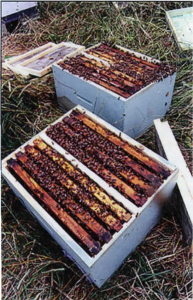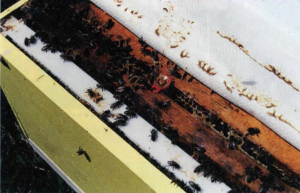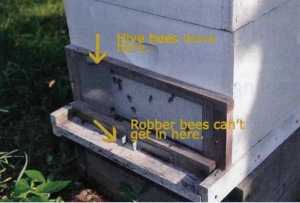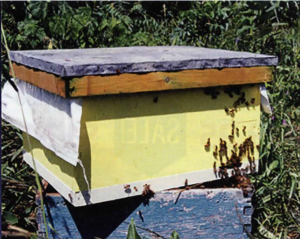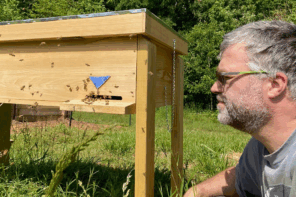By: Larry Connor
This article originally appeared in the Autumn 2016 issue of BEEKeeping Your First Three Years
Summer increase colonies are easy to make up if you follow these simple steps. Allow enough time, and make sure you have everything you’ll need before you begin.
Equipment Preparation
You may want to make up double four- or five-frame nucleus boxes from eight- or ten-frame equipment, depending upon your equipment inventory and your perceived needs. Many beekeepers divide ten-frame, deep hive bodies with a solid board running from the bottom board to the top of the box. They then cut inner covers from animal feed bags which allow them to inspect one nucleus in the box without disturbing the other. Other beekeepers use a solid piece of Masonite or plywood cut to fit between the division board at the top of the frames. An outer cover is placed over both boxes. Staple or nail the bottom board to the box, checking to make sure that the divider is bee tight (this may be done by routing a groove for the divider to slide into). Fill this box with a mixture of drawn combs and frames containing foundation. Ed Simon has reviewed some simple-to-make nucleus equipment in his book Bee Equipment Essentials.
To reduce the chance of injuring the queen cell or the queen herself, and to make manipulation much easier, I often use nine frames in 10-frame equipment. With the divided nucleus box, you may use five frames, or increase the spacing by using four frames on each side. Do not make up special equipment with unusual dimensions – keep in mind your cross utilization elsewhere in your beekeeping operation or future resale value.
Some beekeepers use special division board feeders in the nucleus box. They fill it before they add the queen cell. A few Summers ago, we had a dearth in the Summer and Summer feed was essential for new colony growth. An entrance or hive top feeder may also be used. A frame or two of honey taken to the apiary, or removed from a strong colony, will guarantee a food supply. That said, nothing ensures the success of increase colonies as a nectar flow does. The colony will grow rapidly and be ready for more space very quickly.
Arriving at the apiary
With all the equipment loaded into a vehicle, you are ready to work. If the apiary has been managed so that colonies are about the same strength level, you will be able to remove the same amount of brood, bees and stored honey from each unit. Take what the colony can spare to reduce the swarming instinct from developing but you do not want to weaken the colony so much that it does not produce a honey crop.
Systematically work one hive at a time
Remove whatever frames of brood the colony can spare; usually two or three frames per hive. Also collect frames of honey. Replace the brood frames with drawn comb so the queen will immediately lay into it. If there is a nectar flow underway, replace the honey frame with foundation to increase your number of new frames. Make sure to keep the brood together and not divide it unintentionally. I place drawn comb on the outside of the brood nest and foundation outside that. Drone brood foundation may be added if not already present.
Inspect each frame for a queen. Carefully check each frame for a queen as you remove it from the hive body. As you place frames in the box, inspect each frame again for both the queen and for queen cells. If you find one queen, look for another. Between 10% to 20% of all colonies have mother-daughter queens laying in close proximity to each other. Add brood and bees from multiple hives if needed.
Once filled, place the lid on the colony and screen the entrance, placing the colony in the shade if it is to be moved to another location. If it is to stay in a permanent site within the same apiary, move it to that location and restrict its entrance.
What strength?
As colonies are made up, they may be custom made for the strength needed by the beekeeper. Many increase colonies are often made up lighter earlier in the season because the colony has a longer time period to expand its population. If you seek full production colonies, however, add six or more frames of brood and two or three frames of honey and pollen. If you wish to install queens or queen cells and keep them for production colonies later in the Summer, make up the nucleus colonies with two partial frames of brood, a frame of honey and an empty drawn comb. This will allow the queen an adequate population to support growth but not become so strong as to swarm. If you want to mate the queen in a smaller unit and later move it to 10-frame equipment, add three frames of brood and one frame each of pollen and honey. As you make up these colonies, make sure you move primarily sealed and emerging brood. Look for queen cells in development on any frames since this may interfere with queen or cell acceptance.
Reduce the entrances
Robbing from other colonies is a real problem with small colonies. Once robbing gets started in an apiary, it can be very destructive. This may be avoided by keeping the entrances of smaller colonies reduced with a block of wood or screen. This allows a smaller number of guard bees to protect the colony entrance. If the hives are located in the sun, consider using window or small mesh screen as part of the entrance reducer so the bees are able to get adequate ventilation. Adding screened vent holes helps too.
In areas of chronic robbing, use a robbing screen. These work by allowing the bees inside the hive to fly in and out of the hive using a variation in the entrance. Robber bees are attracted to the odor of a colony, so place screens so they are unable to enter the hive.
Add cell or queen
Once a group of bees have been queenless for several hours, it is safe to introduce a queen cell or a queen in a push-in cage. Many beekeepers do this at the time they make up the colony, relying on the general confusion and mixing of bees to ensure queen acceptance. A cell protector that fits around a queen cell but allows the queen to emerge may be a suitable compromise for those worried about the ‘foreign’ queen cell being destroyed. Personally, I add queen cells after the nucleus or full-sized colony is in its permanent location, either in the same apiary or in another location. This will add several hours to the queenless period, and seems to reduce queen introduction problems.
The use of different colored plastic cell cups allows you to identify the breeder queen or line you grafted from. If you move frames of brood from colonies undergoing swarming, mark the top of the frame with a colored thumbtack. This mark will identify the colony from which you removed the frame.
Using virgin queens
Some queen producers emerge queen cells into small cages in cell builders or vials stored in incubators. I have used small emergence cages for years, producing thousands of virgin queens. These virgin queens may be successfully used in increase colonies if introduced with a candy or marshmallow plug at the end of the cage or the holding cylinder.
Once sited
Leave the increase colony alone so the queen is able to emerge from the cage and become established. If already mated, she should be laying in several days and may be checked, quickly, in five to seven days for acceptance as evidenced by normal egg laying in the brood cells. If you have used a virgin queen or a queen cell, allow three weeks before you check for a laying queen. Allow the queen to emerge, mature, mate and initiate laying. Waiting three weeks before removal is better for the queen, nucleus and the colony the queen is installed into as they mature together.
Follow-up inspections
Let the queen fill the colony with brood and, about four weeks later, evaluate her performance for brood pattern, appearance of newly emerged worker bees, and the appearance of any problems. Make sure the colony continues to have adequate food reserves (one honey frame in five-frame nucleus and three frames in a nine- or 10-frame hive). Queenless colonies should be stacked on top of a strong colony. Watch for wax moth and hive beetle larvae in queenless colonies.







